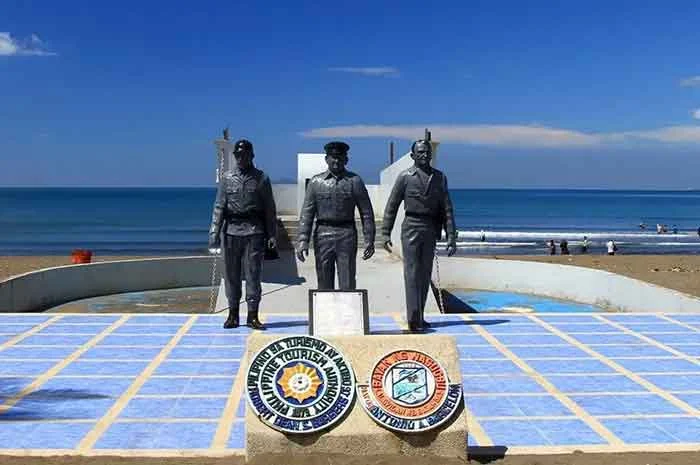[WWII] The Nasugbu Landing of January 1945 from the Japanese Perspective
Most of the information available on Operation Mike VI, more commonly remembered as the “Nasugbu Landing” of 31 January 1945, is understandably from the American perspective. On the said date, the United States Eighth Army under the command of General Robert L. Eichelberger, landed troops on the beaches of Nasugbu in western Batangas in support of the invasion of Lingayen Gulf earlier in the same month.
It is well established from earlier narratives written that the operation, initially set up as a “reconnaissance in force1,” became a full invasion upon confirmation that Nasugbu was, indeed, lightly defended by forces of the Japanese Imperial Army (JIA). Why this was so was explained by a declassified United States Army document with information obtained from the interrogation of Captain Eikichi Ysegashi of the 10th Company, 2nd Battalion, 31st Infantry Regiment of the JIA2.
The defense of the Tagaytay-Nasugbu area had been given to the 8th Division of the Japanese Army. An initial part of the 31st Regiment sailed from Fusan (most likely “Busan”) in Japanese-occupied Korea to a port in San Fernando, Luzon in August of 1944.
The journey was perilous, and in fact, the regiment’s 2nd Battalion lost 150 men after a transport ship carrying them was sunk by a United States Navy submarine. Another 200 men or so were lost on the 5th of September after a second transport ship was sunk by another submarine attack.
 |
| The Nasugbu Landing Memorial on the beach at Nasugbu. Image credit: American War Memorials Overseas, Inc. |
After a brief layover in Formosa4, what remained of the 31st Regiment’s initially batch of troops finally arrived at San Fernando harbor, most likely in La Union. From there, the troops traveled to Manila by train, staying at the country’s capital for two days until ordered to hike to Tagaytay on the 29th of September.
Since the main body of the regiment was still en route to Luzon, by early October, the early arrivals started preparing defensive positions in Tagaytay after scouting the terrain. Roads were also constructed on Mt. Batulao and Mt. Cariliao, both at the Nasugbu-Cavite border, by troops of the 7th and 8th companies, respectively.
The regiment’s main body finally arrived in Luzon soon afterwards and made haste for Tagaytay to reunite with the early arrivals. Although the regiment had suffered severe losses in personnel en route, it was augmented with fresh troops from both Formosa and Manila, reorganized and given the task of defending the Tagaytay-Nasugbu area.
When the Japanese learned of the Allied landing on the beaches of Leyte on the 20th of October, the 5th Regiment, also of the 8th Division, was ordered south to help repel the invasion. The positions left behind by the 5th Regiment were taken over by the 1st Battalion of the 31st Regiment, or 3,000 soldiers or so less.
Moreover, by the end of December, the bulk of the 31st Regiment stationed in the Nasugbu-Tagaytay were ordered north to the Ipo Dam area to support the Shimbu Group of the JIA. Thus, the defense of the Nasugbu area was left in the hands of the 3rd Battalion of the 31st Regiment5.
Numbering in the neighborhood of 5,000 men in December, the following month, when the invasion of Luzon was scheduled to be undertaken by the Allied Forces, the number of troops available to the 31st Infantry Regiment to defend the Nasugbu area had been significantly reduced by the deployment north to a mere 800 or so soldiers.
The redeployment of troops because of the Allied invasions of Leyte and Lingayen Gulf also meant that in the Nasugbu-Tagaytay area, the construction of “adequate defense positions and the stocking of ammunition and foodstuffs had not been accomplished at the time of the American invasion6.”
The numerous Filipino guerrilla outfits that had converged in the area in anticipation of the Allied landing also contributed to the misery of the Japanese. The guerrillas had been given orders to sever Japanese communication lines on the eve of the Nasugbu landing, so that according to Ysegashi, news of the landing could not be communicated to all units and this created confusion.
1 A “reconnaissance-in-force” is “a deliberate combat operation to discover or test the enemy’s strength... to allow the main body to exploit the weakness.” “Understanding Reconnaissance Missions Instead of Focusing on Reconnaissance Platforms,” by CPT Kyle Holsington, date of publication unknown, online at The U.S. Army Fort Benning and the Maneuver Center of Excellence.
2 “Staff Study of Japanese Operations in the Batangas Area (Nasugbu Operation), by the Special Staff U.S. Army History Division, 10th Information and Historical Service, date written unknown, online at the Ike Skelton Combine Arms Research Library Digital Library.
3 A regiment of the Imperial Japanese Army in World War II consisted of just under 4,000 men, commanded by a Colonel. A division, meanwhile, consisted of some 20,000 troops, and was commanded by a Lieutenant General. “Organization of the Imperial Japanese Army,” Wikipedia.
4 Formosa, or present-day Taiwan, was Japanese-occupied territory in World War II.
5 The 3rd Battalion of the JIA’s 31st Infantry was the nucleus of the “West Sector Unit,” numbering about 2,250 men, which was deployed by Col. Masatoshi Fujishige of the so-called “Fuji Force” to defend the Nasugbu-Tagaytay area. “The US Army in World War II: the War in the Pacific, Triumph in the Philippines,” by Robert Ross Smith, published 1963.
6 Special Staff U.S. Army History Division, op cit.
